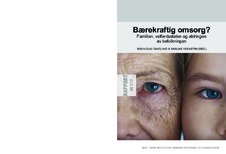| dc.description.abstract | This report concludes the PopAge project (Population ageing and long-term care: the family-welfare state balance revisited), financed by the Norwegian Research Council, and carried out in 2009–2011 at NOVA. Ageing of the population changes in a fundamental way the balance between generations in the family as well as in the welfare state. The primary objective of the project was to build new knowledge about the changing role of the family and the welfare state in current Norwegian long-term care systems, and to evaluate the risk for increasing social inequalities in response to population ageing. Secondary, more specific objectives were, to explore the needs, motivations and barriers for family care, to describe the character and consequences of different mixes of formal and informal care, and to inform policies that may support a fair distribution of public long-term care resources. The report is organised in four sections. Part I (Chapter 1) introduces the project and research questions, and describes basic perspectives, data and methodologies. Part II provides a macro perspective on long-term care in four chapters. Chapter 2 summarizes current knowledge about population ageing, including the assessment of health among future elders: Do we live longer in good health, or in poor health? So far, research indicates support for the dynamic equilibrium hypothesis, implying longer lives with disease. But care needs are postponed to a later – and shorter – period of late life. Chapter 3 describes the position of elders in the welfare state in general, and in long-term care in particular, and what is to be expected in the coming years. Estimates vary considerably; hence there is considerable uncertainty in projections. According to a medium alternative, total expenses (and employment) in long-term care is expected to double over the next forty years, but will yet stay within a limit of around four per cent of GDP. Chapter 4 outlines the development of long-term care services since the 1960s. Norway is among the countries with the most generous access to public services, but services have leveled off, and even declined the later years. De-institutionalization characterises care for younger clients, whereas institutional care (nursing homes) is still dominant in elder care. Services are mainly public, provided by local governments, but increasingly subject to a contracting out policy. Chapter 5 analyses local variations in long-term care, which is considerable between the 430 Norwegian municipalities, not only in volume, but also in profile of services. The smaller municipalities have in general the higher volume of services, partly because needs are larger, and partly because of more generous state subsidies. Part III includes four chapters with analyses of health, family networks, and care exchanges based in a large, nationally representative survey. Chapter 6 describes how family networks, and needs, vary over the life course, including the risk of being squeezed between obligations towards young children and old parents. Chapter 7 analyses help relationships – the role of families, and the welfare state for care of older (parents) and younger persons in need. The family and welfare state balance in elder care is estimated to around 50–50, but the welfare state (public services) dominates when nursing care is needed, primarily because elders with extensive needs sooner or later move into assisted housing or a nursing home. Chapter 8 describes the pathways to the nursing home via qualitative interview with the primary family carer of a number of elders who have recently been institutionalized. These pathways are quite different, gradual and acute, short-term and long-term, but common for all of them is a period in hospital prior to the nursing home. Norms and preferences for care are discussed in chapter 9. Norwegian attitudes about the role of families and the welfare state are compared to attitudes in other countries, indicating that family norms are less strict, and the belief in the welfare state more strong, in Norway than in countries further south and east on the European continent. Elder care is in Norway seen as a welfare state responsibility, but supplemented with family care. Other countries tend to leave the main responsibility with the family. The final Part IV adds comparative perspectives (Chapter 10), and concludes the report with a discussion about sustainable care (Chapter 11). The Nordic model is expensive, and need support from a trust in government and a willingness to pay taxes. The continental model is hard to reconcile with modern family life and equal opportunities for women and men. Population ageing indicates a need for larger investments in the welfare state, but moderately so in Norway compared to many other countries, where ageing is more radical and current services less available. There is likely a limit for what a country can spend on «social issues», but we are hardly there yet. A sustainable care system need both the family and the welfare state, but families can hardly shoulder more than today when populations get older. The solution lies therefore mainly in the welfare state, and is not primarily a question of resources, but of solidarity. | en |
| dc.description.abstract | Aldringen av befolkningen endrer balansen mellom generasjonene og forutsetningene for en bærekraftig omsorg. Rapporten kartlegger behov og omsorg over livsløpet, utviklingen av omsorgstjenestene, variasjonen mellom kommunene, idealer og realiteter i dagens situasjon og dilemmaer for årene framover. Rapporten avrunder prosjektet «Aldringen av befolkningen og ansvarsdelingen mellom familien og velferdsstaten», som ble finansiert av program for Helse- og omsorgstjenester ved Norges forskningsråd og gjennomført ved NOVA med bidrag fra Statistisk sentralbyrå. Flere datakilder og metoder er anvendt, dels surveydata fra de to store livsløpsundersøkelsene ved NOVA: NorLAG og LOGG, og dels registerdata fra Statistisk sentralbyrås databaser for kommunene (KOSTRA) og brukerne av omsorgstjenester (IPLOS), og supplert med kvalitative intervjuer. | no_NB |
